Nano-Enhanced Phase Change Materials for Thermal Energy Storage: A Bibliometric Analysis
Abstract
:1. Introduction
1.1. Thermal Energy Storage
1.2. PCMs in LHTES
2. Overview of NePCMs
3. Methodology
4. Results and Discussion
4.1. Main Information
4.2. Analysis of Keywords
4.3. Productivity and Growth Rate
4.4. Authorship and Countries Evolution
5. Conclusions
Author Contributions
Funding
Data Availability Statement
Conflicts of Interest
Nomenclature
| Acronyms | |
| FEM | Finite element method |
| FVM | Finite volume method |
| HTF | Heat transfer fluid |
| LHTES | Latent heat thermal energy storage |
| NePCM | Nano-enhanced phase change material |
| NEPCM | Nano encapsulated phase change material |
| PCM | Phase change material |
| TES | Thermal energy storage |
References
- Khodadadi, M.; Sheikholeslami, M. Numerical simulation on the efficiency of PVT system integrated with PCM under the influence of using fins. Sol. Energy Mater. Sol. Cells 2021, 233, 111402. [Google Scholar] [CrossRef]
- Tofani, K.; Tiari, S. Nano-Enhanced Phase Change Materials in Latent Heat Thermal Energy Storage Systems: A Review. Energies 2021, 14, 3821. [Google Scholar] [CrossRef]
- Nazir, H.; Batool, M.; Osorio, F.J.B.; Isaza-Ruiz, M.; Xu, X.; Vignarooban, K.; Phelan, P.; Inamuddin; Kannan, A.M. Recent developments in phase change materials for energy storage applications: A review. Int. J. Heat Mass Transf. 2019, 129, 491–523. [Google Scholar] [CrossRef]
- Barnes, F.; Levine, J. Large Energy Storage Systems; Taylor & Francis Group: New York, NY, USA, 2011. [Google Scholar]
- Huang, Z.; Xie, N.; Luo, Z.; Gao, X.; Fang, X.; Fang, Y.; Zhang, Z. Characterization of medium-temperature phase change materials for solar thermal energy storage using temperature history method. Sol. Energy Mater. Sol. Cells 2018, 179, 152–160. [Google Scholar] [CrossRef]
- Chaturvedi, R.; Islam, A.; Sharma, K. A review on the applications of PCM in thermal storage of solar energy. Mater. Today Proc. 2021, 43, 293–297. [Google Scholar] [CrossRef]
- Qiu, L.; Ouyang, Y.; Feng, Y.; Zhang, X. Review on micro/nano phase change materials for solar thermal applications. Renew. Energy 2019, 140, 513–538. [Google Scholar] [CrossRef]
- Saffari, M.; de Gracia, A.; Fernández, C.; Cabeza, L.F. Simulation-based optimization of PCM melting temperature to improve the energy performance in buildings. Appl. Energy 2017, 202, 420–434. [Google Scholar] [CrossRef] [Green Version]
- Jia, J.; de Gracia, A.; Fernández, C.; Cabeza, L.F. Energy saving performance optimization and regional adaptability of prefabricated buildings with PCM in different climates. Case Stud. Therm. Eng. 2021, 26, 101164. [Google Scholar] [CrossRef]
- Park, J.H.; Berardi, U.; Chang, S.J.; Wi, S.; Kang, Y.; Kim, S. Energy retrofit of PCM-applied apartment buildings considering building orientation and height. Energy 2021, 222, 119877. [Google Scholar] [CrossRef]
- Mozafari, M.; Lee, A.; Mohammadpour, J. Thermal management of single and multiple PCMs based heat sinks for electronics cooling. Therm. Sci. Eng. Prog. 2021, 23, 100919. [Google Scholar] [CrossRef]
- Sarrafha, H.; Kasaeian, A.; Jahangir, M.H.; Taylor, R.A. Transient thermal response of multi-walled carbon nanotube phase change materials in building walls. Energy 2021, 224, 120120. [Google Scholar] [CrossRef]
- Senthil, R. Effect of position of heat transfer fluid tube on the melting of phase change material in cylindrical thermal energy storage. Energy Sources Part A Recovery Util. Environ. Eff. 2019, 44, 2374–2384. [Google Scholar] [CrossRef]
- Gong, Z.-X.; Mujumdar, A.S. A New Solar Receiver Thermal Store for Space-Based Activities Using Multiple Composite Phase-Change Materials. J. Sol. Energy Eng. 1995, 117, 215–220. [Google Scholar] [CrossRef]
- Al Siyabi, I.; Khanna, S.; Mallick, T.; Sundaram, S. Multiple Phase Change Material (PCM) Configuration for PCM-Based Heat Sinks—An Experimental Study. Energies 2018, 11, 1629. [Google Scholar] [CrossRef] [Green Version]
- Tiari, S.; Qiu, S. Three-dimensional simulation of high temperature latent heat thermal energy storage system assisted by finned heat pipes. Energy Convers. Manag. 2015, 105, 260–271. [Google Scholar] [CrossRef]
- Tiari, S.; Qiu, S.; Mahdavi, M. Numerical study of finned heat pipe-assisted thermal energy storage system with high temperature phase change material. Energy Convers. Manag. 2015, 89, 833–842. [Google Scholar] [CrossRef]
- Mohammadpour, J.; Salehi, F.; Lee, A. Performance of nano encapsulated phase change material slurry heat transfer in a microchannel heat sink with dual-circular synthetic jets. Int. J. Heat Mass Transf. 2022, 184, 122265. [Google Scholar] [CrossRef]
- Mohammadpour, J.; Lee, A. Investigation of nanoparticle effects on jet impingement heat transfer: A review. J. Mol. Liq. 2020, 316, 113819. [Google Scholar] [CrossRef]
- Khodadadi, J.M.; Hosseinizadeh, S.F. Nanoparticle-enhanced phase change materials (NEPCM) with great potential for improved thermal energy storage. Int. Commun. Heat Mass Transf. 2007, 34, 534–543. [Google Scholar] [CrossRef]
- Leong, K.Y.; Rahman, M.R.A.; Gurunathan, B.A. Nano-enhanced phase change materials: A review of thermo-physical properties, applications and challenges. J. Energy Storage 2019, 21, 18–31. [Google Scholar] [CrossRef]
- Khodadadi, J.M.; Fan, L.; Babaei, H. Thermal conductivity enhancement of nanostructure-based colloidal suspensions utilized as phase change materials for thermal energy storage: A review. Renew. Sustain. Energy Rev. 2013, 24, 418–444. [Google Scholar] [CrossRef]
- Siegel, R. Solidification of low conductivity material containing dispersed high conductivity particles. Int. J. Heat Mass Transf. 1977, 20, 1087–1089. [Google Scholar] [CrossRef]
- Seeniraj, R.; Velraj, R.; Narasimhan, N.L. Heat transfer enhancement study of a LHTS unit containing dispersed high conductivity particles. J. Sol. Energy Eng. 2002, 124, 243–249. [Google Scholar] [CrossRef]
- Elgafy, A.; Lafdi, K. Effect of carbon nanofiber additives on thermal behavior of phase change materials. Carbon 2005, 43, 3067–3074. [Google Scholar] [CrossRef]
- Yazdanifard, F.; Ameri, M.; Taylor, R. Parametric investigation of a nanofluid-NEPCM based spectral splitting photovoltaic/thermal system. Energy Convers. Manag. 2021, 240, 114232. [Google Scholar] [CrossRef]
- Hosseini, S.M.J.; Ranjbar, A.A.; Sedighi, K.; Rahimi, M. Melting of nanoprticle-enhanced phase change material inside shell and tube heat exchanger. J. Eng. 2013, 2013, 784681. [Google Scholar] [CrossRef] [Green Version]
- Aqib, M.; Hussain, A.; Ali, H.M.; Naseer, A.; Jamil, F. Experimental case studies of the effect of Al2O3 and MWCNTs nanoparticles on heating and cooling of PCM. Case Stud. Therm. Eng. 2020, 22, 100753. [Google Scholar] [CrossRef]
- TEMEL, Ü.N.; ÇİFTÇİ, B.Y. Determination of thermal properties of A82 organic phase change material embedded with different type nanoparticles. Isı Bilimi Ve Tek. Derg. 2018, 38, 75–85. [Google Scholar]
- Javadi, H.; Urchueguia, J.F.; Ajarostaghi, S.S.M.; Badenes, B. Numerical study on the thermal performance of a single U-tube borehole heat exchanger using nano-enhanced phase change materials. Energies 2020, 13, 5156. [Google Scholar] [CrossRef]
- Calderón, A.; Barreneche, C.; Hernández-Valle, K.; Galindo, E.; Segarra, M.; Fernández, A.I. Where is Thermal Energy Storage (TES) research going—A bibliometric analysis. Sol. Energy 2020, 200, 37–50. [Google Scholar] [CrossRef]
- Saikia, K.; Vallès, M.; Fabregat, A.; Saez, R.; Boer, D. A bibliometric analysis of trends in solar cooling technology. Sol. Energy 2020, 199, 100–114. [Google Scholar] [CrossRef]
- Cabeza, L.F.; Frazzica, A.; Chàfer, M.; Vérez, D.; Palomba, V. Research trends and perspectives of thermal management of electric batteries: Bibliometric analysis. J. Energy Storage 2020, 32, 101976. [Google Scholar] [CrossRef]
- Yataganbaba, A.; Ozkahraman, B.; Kurtbas, I. Worldwide trends on encapsulation of phase change materials: A bibliometric analysis (1990–2015). Appl. Energy 2017, 185, 720–731. [Google Scholar] [CrossRef]
- Björk, B.-C.; Hedlund, T. Emerging new methods of peer review in scholarly journals. Learn. Publ. 2015, 28, 85–91. [Google Scholar] [CrossRef]
- Glänzel, W.; Moed, H.F. Journal impact measures in bibliometric research. Scientometrics 2002, 53, 171–193. [Google Scholar] [CrossRef]
- de Paulo, A.F.; Porto, G.S. Solar energy technologies and open innovation: A study based on bibliometric and social network analysis. Energy Policy 2017, 108, 228–238. [Google Scholar] [CrossRef]
- Cabeza, L.F.; Chàfer, M.; Mata, É. Comparative analysis of web of science and scopus on the energy efficiency and climate impact of buildings. Energies 2020, 13, 409. [Google Scholar] [CrossRef] [Green Version]
- Van Eck, N.J.; Waltman, L. Software survey: VOSviewer, a computer program for bibliometric mapping. Scientometrics 2010, 84, 523–538. [Google Scholar] [CrossRef] [Green Version]
- Aria, M.; Cuccurullo, C. Bibliometrix: An R-tool for comprehensive science mapping analysis. J. Informetr. 2017, 11, 959–975. [Google Scholar] [CrossRef]
- Black, P.E. Bradford’s Law, in Dictionary of Algorithms and Data Structures; US National Institute of Standards and Technology: Gaithersburg, MD, USA, 2004; p. 24.
- Hirsch, J.E. An index to quantify an individual’s scientific research output. Proc. Natl. Acad. Sci. USA 2005, 102, 16569–16572. [Google Scholar] [CrossRef] [Green Version]
- Egghe, L. Theory and practise of the g-index. Scientometrics 2006, 69, 131–152. [Google Scholar] [CrossRef]
- Kim, S.; Drzal, L.T. High latent heat storage and high thermal conductive phase change materials using exfoliated graphite nanoplatelets. Sol. Energy Mater. Sol. Cells 2009, 93, 136–142. [Google Scholar] [CrossRef]
- Yavari, F.; Raeisi Fard, H.; Pashayi, K.; Rafiee, M.A.; Zamiri, A.; Yu, Z.; Ozisik, R.; Borca-Tasciuc, T.; Koratkar, N. Enhanced thermal conductivity in a nanostructured phase change composite due to low concentration graphene additives. Am. Chem. Soc. 2011, 115, 8753–87583. [Google Scholar]
- Ibrahim, N.I.; Al-Sulaiman F., A.; Rahman, S.; Yilbasb, B.S.; Sahin, A.Z. Heat transfer enhancement of phase change materials for thermal energy storage applications: A critical review. Renew. Sustain. Energy Rev. 2017, 74, 26–50. [Google Scholar] [CrossRef]
- Cui, Y.; Liu, C.; Yu, X. The experimental exploration of carbon nanofiber and carbon nanotube additives on thermal behavior of phase change materials. Sol. Energy Mater. Sol. Cells 2011, 95, 1208–1212. [Google Scholar] [CrossRef]
- Ho, C.J.; Gao, J.Y. Preparation and thermophysical properties of nanoparticle-in-paraffin emulsion as phase change material. Int. Commun. Heat Mass Transf. 2009, 36, 467–470. [Google Scholar] [CrossRef]
- Wang, J.; Xie, H.; Xin, Z.; Li, Y.; Chen, L. Enhancing thermal conductivity of palmitic acid based phase change materials with carbon nanotubes as fillers. Sol. Energy 2010, 84, 339–344. [Google Scholar] [CrossRef]
- Wang, J.; Xie, H.; Xin, Z. Thermal properties of paraffin based composites containing multi-walled carbon nanotubes. Thermochim. Acta 2009, 488, 39–42. [Google Scholar] [CrossRef]
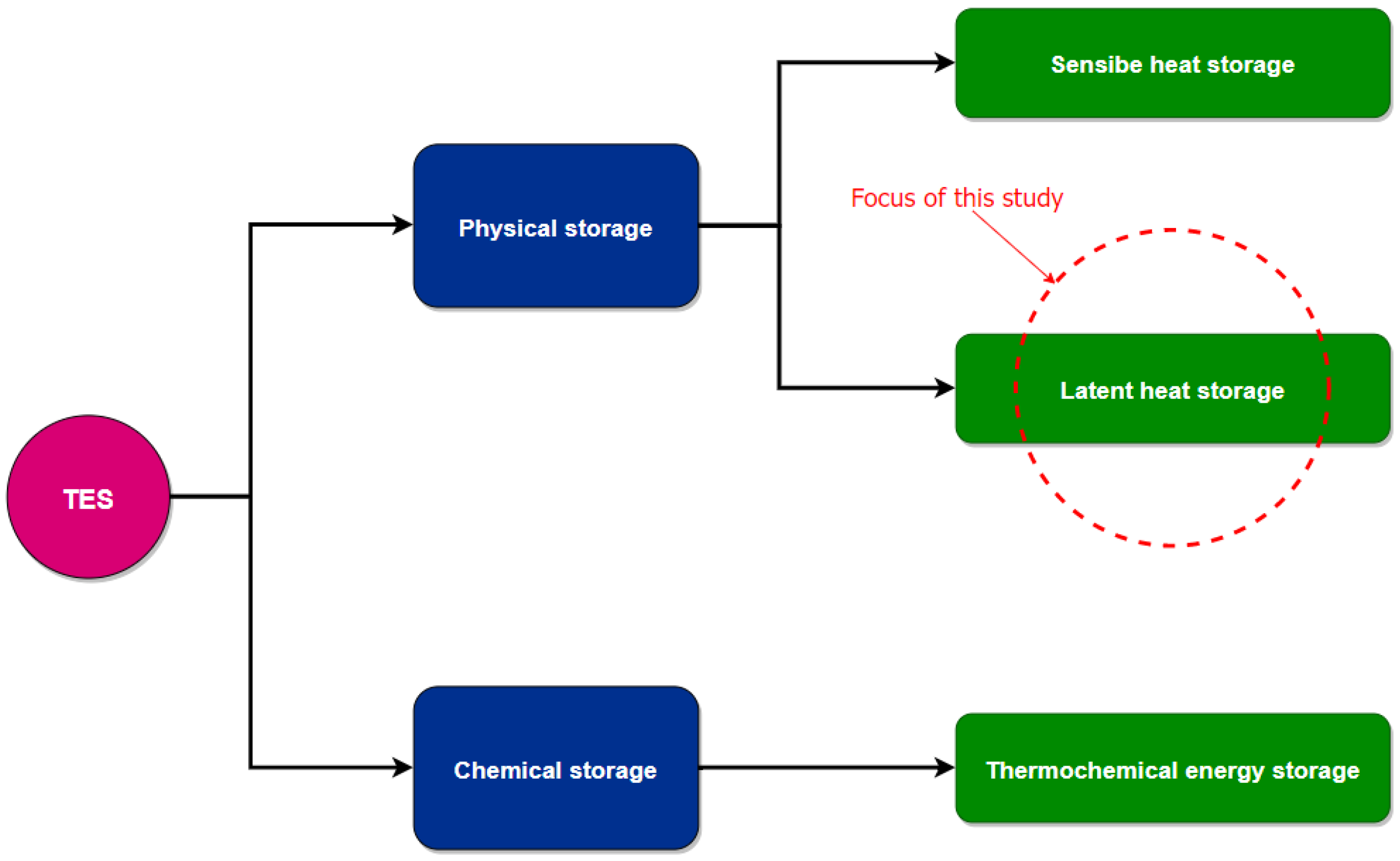

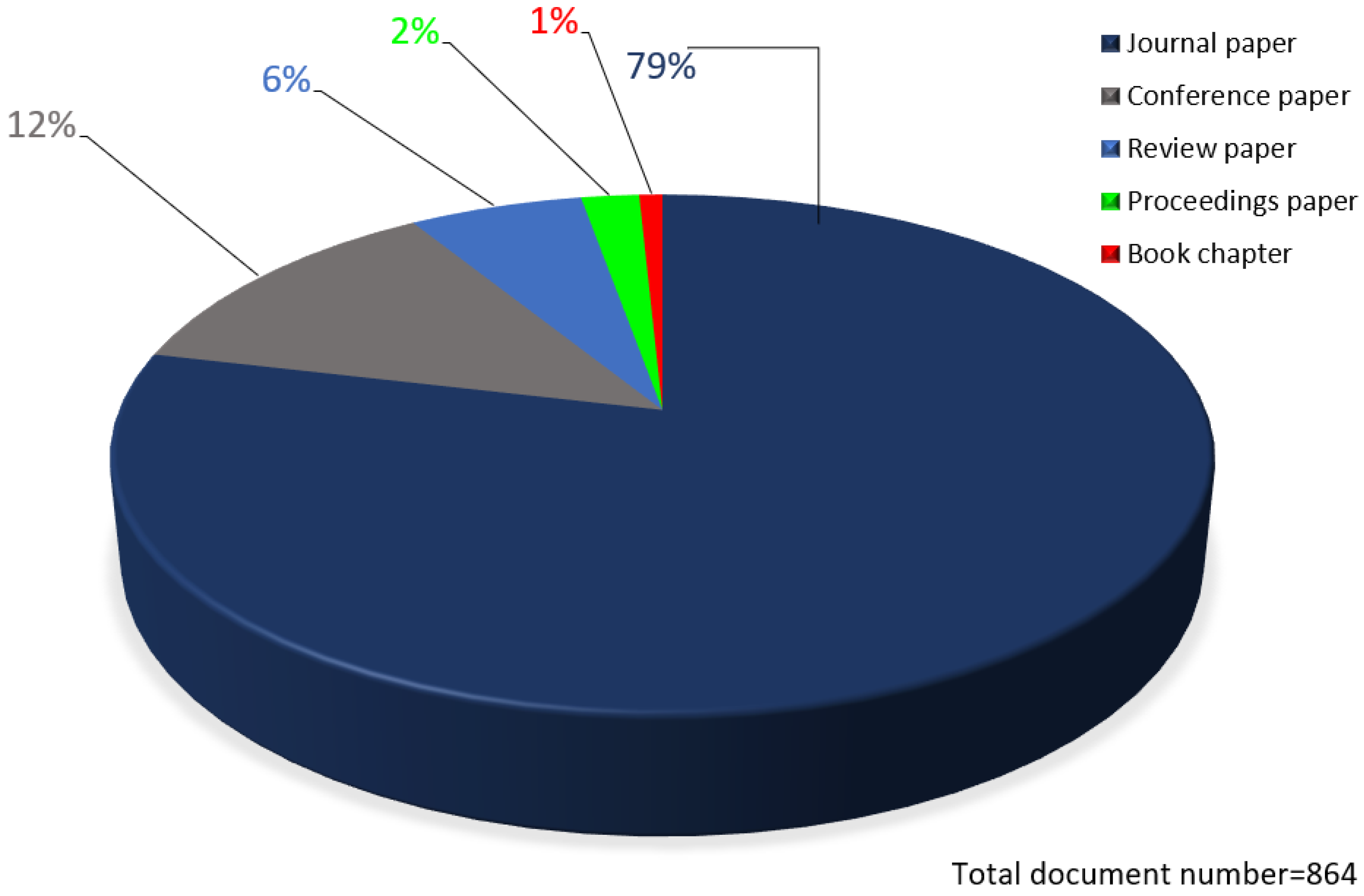

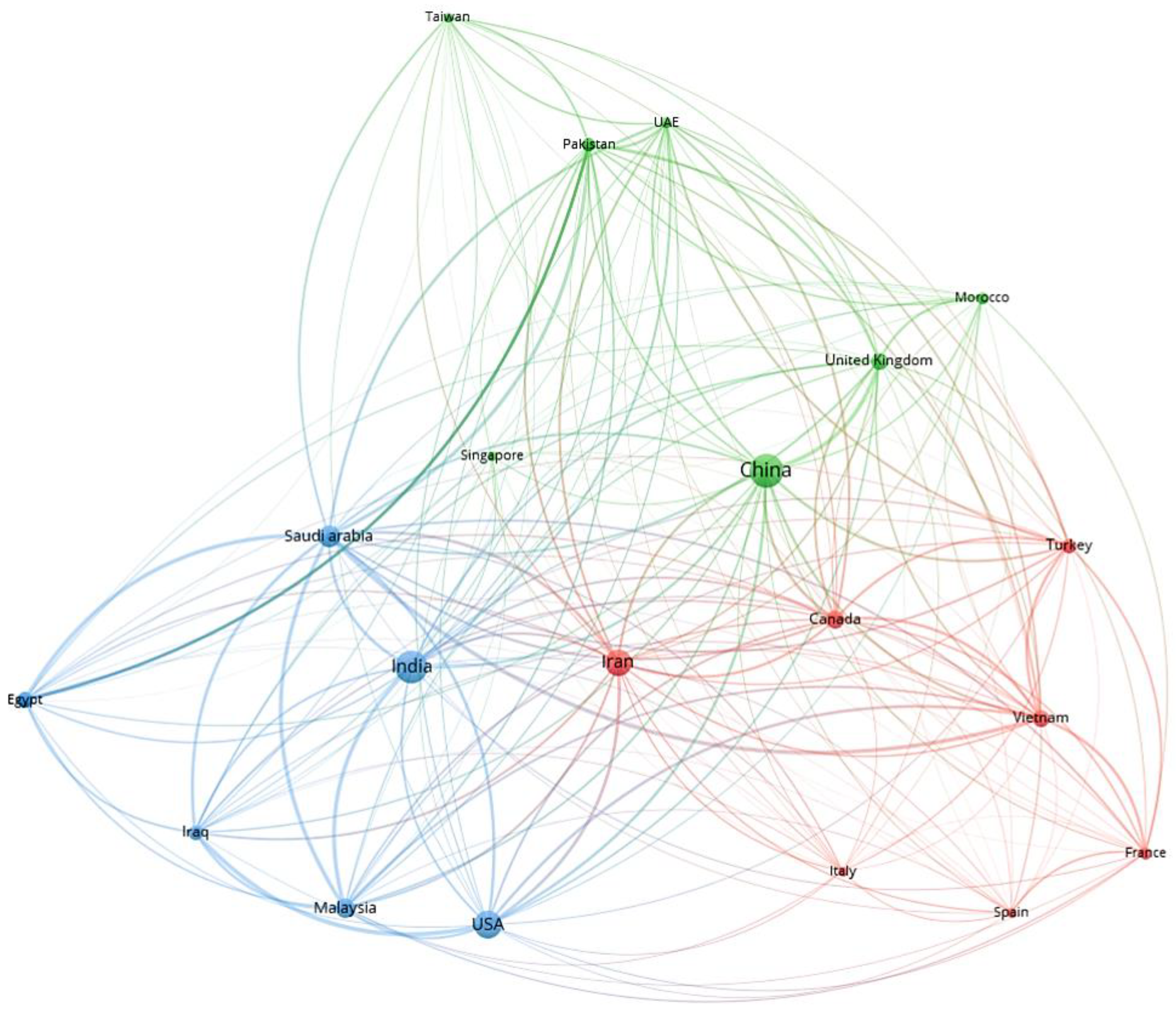
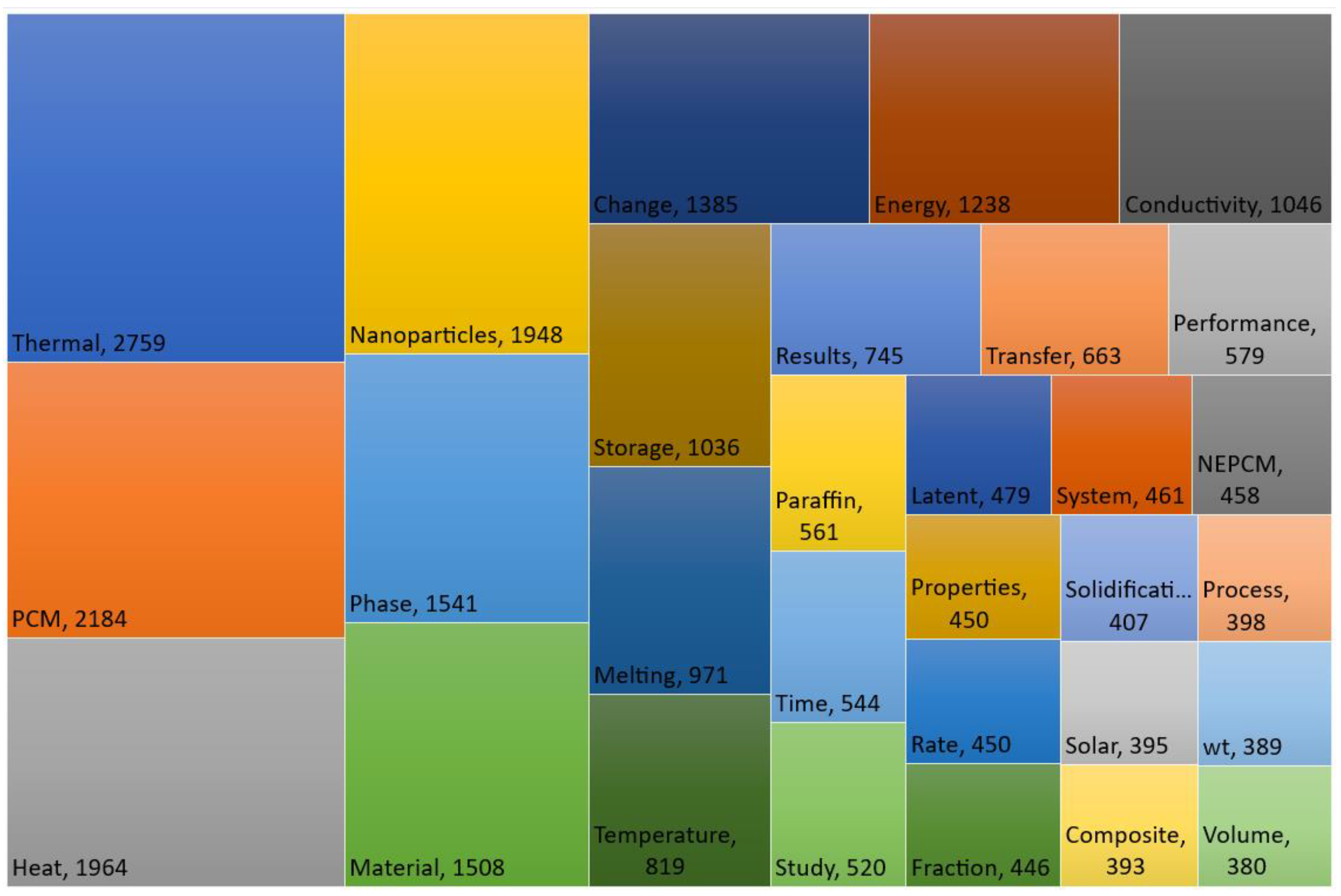
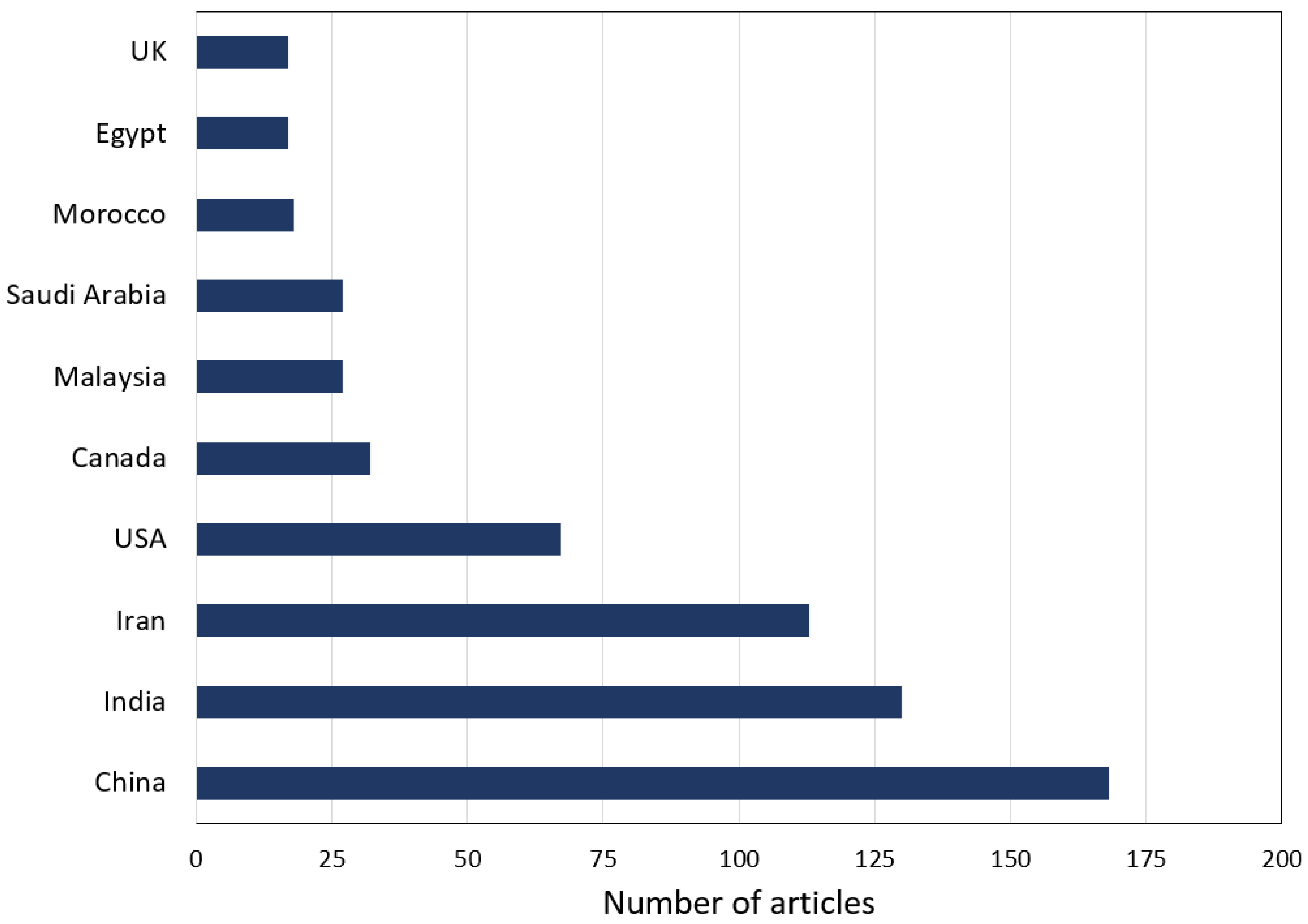
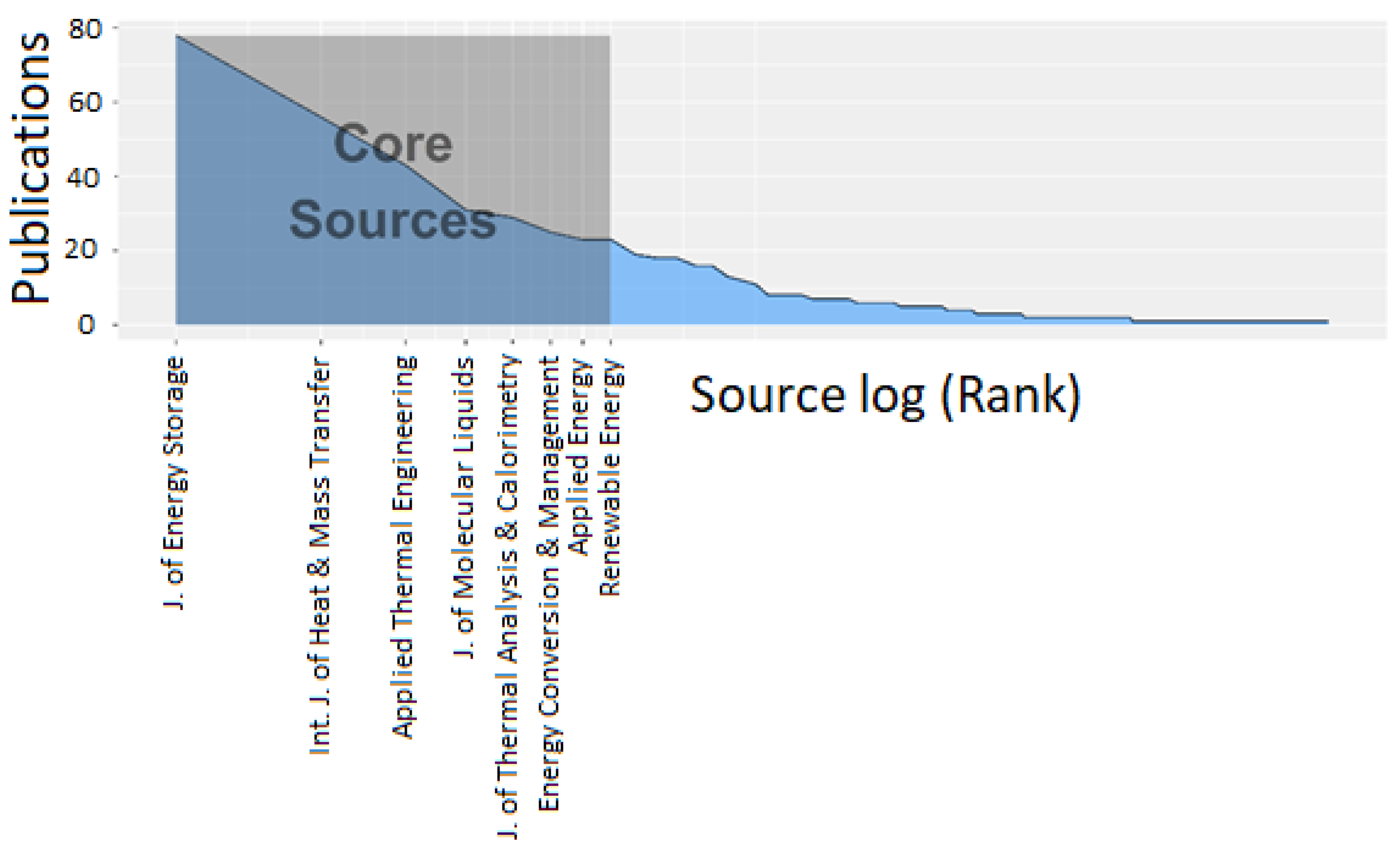

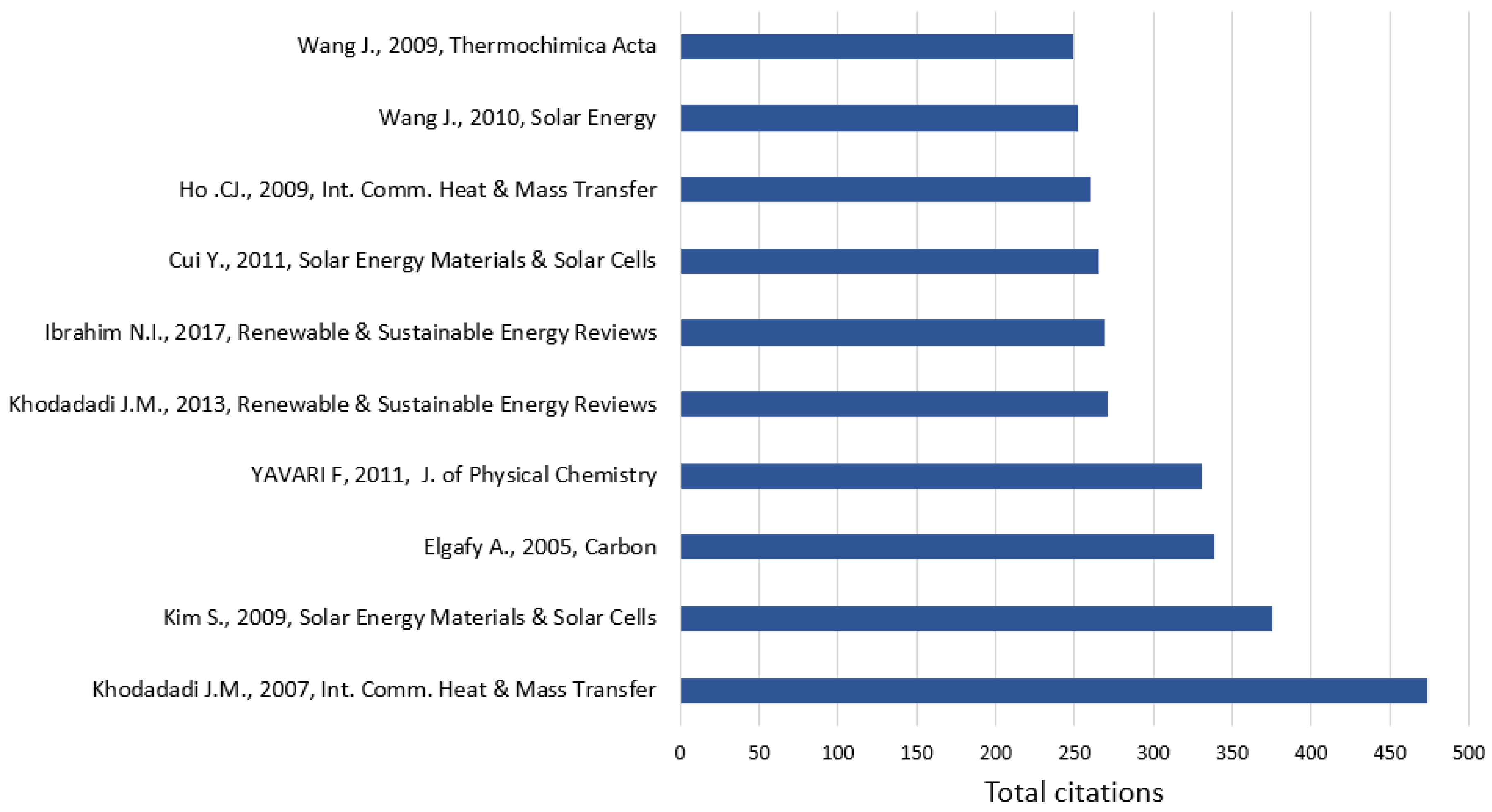
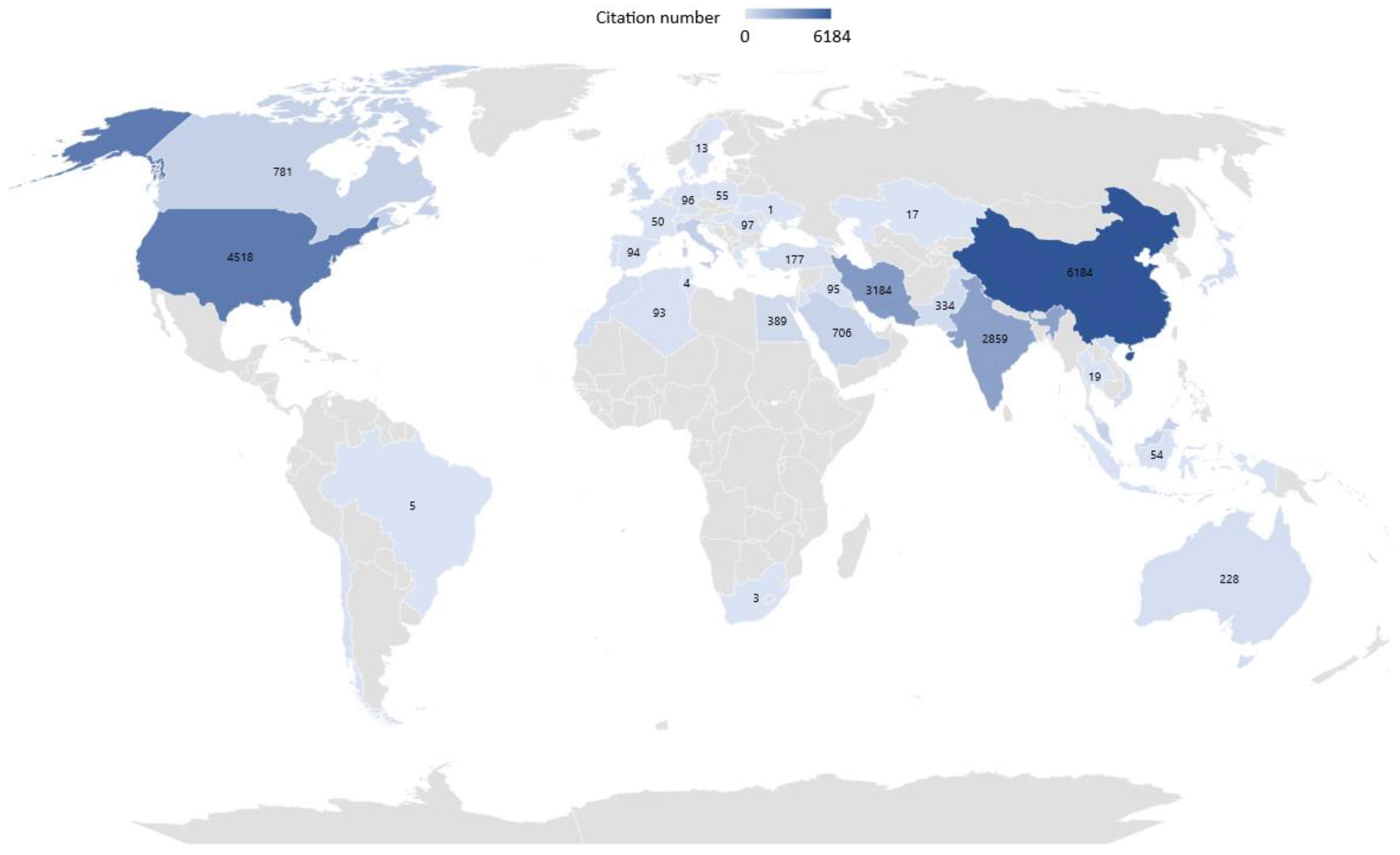
| Terms | Frequency |
|---|---|
| Phase change material | 296 |
| Nanoparticles | 160 |
| Thermal energy storage | 146 |
| Thermal conductivity | 119 |
| PCM | 90 |
| Solidification | 83 |
| Melting | 78 |
| Nanoparticle | 78 |
| Nanofluid | 41 |
| NEPCM | 36 |
| Author | Affiliation | N. of Papers | Index | Citations | ||
|---|---|---|---|---|---|---|
| H | G | M | ||||
| Sheikholeslami M. | Babol Noshirvani University of Technology, Iran | 33 | 19 | 33 | 2.7 | 2039 |
| Shafee A. | Duy Tan University, Vietnam | 20 | 13 | 20 | 2.6 | 776 |
| Ganji D.D. | Babol Noshirvani University of Technology, Iran | 19 | 17 | 19 | 2.4 | 809 |
| Ghalambaz M. | Ton Duc Thang University, Vietnam | 19 | 10 | 19 | 1.7 | 623 |
| Khodadadi J.M. | Auburn University, USA | 13 | 12 | 13 | 0.7 | 1404 |
| Wang J. | Hebei University of Technology, China | 13 | 9 | 13 | 0.6 | 929 |
| Fan L.W. | Zhejiang University, China | 13 | 8 | 13 | 0.8 | 281 |
| Mehryan S.A.M. | Islamic Azad University, Iran | 13 | 6 | 13 | 2 | 189 |
| Kalaiselvam S. | Anna University, India | 12 | 12 | 12 | 1. 1 | 586 |
| Zhang X. | University of Science and Technology Beijing, China | 12 | 6 | 12 | 0.5 | 390 |
Publisher’s Note: MDPI stays neutral with regard to jurisdictional claims in published maps and institutional affiliations. |
© 2022 by the authors. Licensee MDPI, Basel, Switzerland. This article is an open access article distributed under the terms and conditions of the Creative Commons Attribution (CC BY) license (https://creativecommons.org/licenses/by/4.0/).
Share and Cite
Mohammadpour, J.; Lee, A.; Timchenko, V.; Taylor, R. Nano-Enhanced Phase Change Materials for Thermal Energy Storage: A Bibliometric Analysis. Energies 2022, 15, 3426. https://doi.org/10.3390/en15093426
Mohammadpour J, Lee A, Timchenko V, Taylor R. Nano-Enhanced Phase Change Materials for Thermal Energy Storage: A Bibliometric Analysis. Energies. 2022; 15(9):3426. https://doi.org/10.3390/en15093426
Chicago/Turabian StyleMohammadpour, Javad, Ann Lee, Victoria Timchenko, and Robert Taylor. 2022. "Nano-Enhanced Phase Change Materials for Thermal Energy Storage: A Bibliometric Analysis" Energies 15, no. 9: 3426. https://doi.org/10.3390/en15093426







